The following describes the steps needed to complete the DBR.
1. Identify the need for DBR
ACPA and an FHWA identified conditions that will benefit from DBR. Those conditions are:
- Load transfer efficiency (LTE) of 60 percent or less
- Faulting greater than 0.1 inch
- Differential deflection of 10 mils or more
Since the load transfer efficiency and deflections depend on the temperature conditions of concrete, the above criteria a) and c) need to have reference temperature. Also, the determination of LTE and deflections require the use of FWD, while the magnitude of faulting requires a simple ruler. Even though Georgia Fault Meter is much more sophisticated than a simple ruler and has been used in other states, a simple ruler will do the job for the determination of the need for DBR. If the faulting is due to deficient base support, DBR alone should not be used to restore LTE. In this case, subbase repair should be done along with DBR.
For young pavement where the pavement condition is satisfactory but dowels were not used, DBR can be used to strengthen the pavement’s structural conditions. This is more of a preventive maintenance type operation.
2. Cut the slots
Once the need for DBR is established, the next step is to cut the slots using diamond saw slot cutters. It is customary to provide three dowel bars in each wheel path. The diamond saw slot cutter shown in Figure 1 cuts multiple slots in a single pass. These cuts form the edges of the slots. When cutting slots, it is important that the slots are aligned parallel to centerlines. The slots need to be sufficiently wide to permit the largest aggregates in the concrete mix or proprietary mix to flow around the bars and consolidate properly.

Figure 2 below shows the cuts made for slots. Slots are usually 12 inches apart center to center. Note that the cuts are clean and no spalling is observed on the edges of the slots.
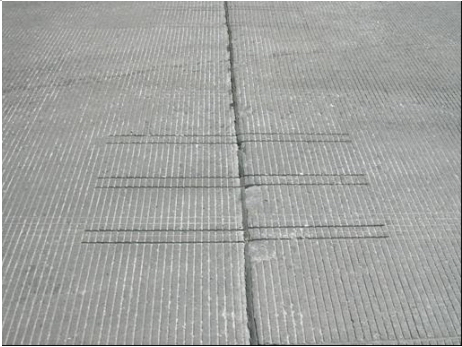
3. Prepare the slots
Slot preparation consists of (1) removing the concrete fins, (2) flattening the bottom, (3) cleaning the slots, and (4) caulking the joint. Small hand-held jackhammers are used to remove the fins as shown in Figure 3. Once the fins are removed, the bottom of the slots is flattened using a small brush hammerhead. The flat slot bottom allows the dowels to sit level and be properly aligned. Normally, the slots are cleaned with sand blasting first as shown in Figure 4. Figure 5 shows the flat bottom after being water cleaned. Maintaining clean slots is important since the bond between backfilling material and slots is critical to providing good load transfer. Joint caulking is necessary to prevent patch material from entering the joint.
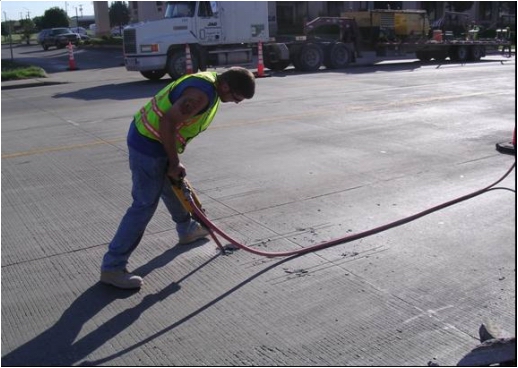
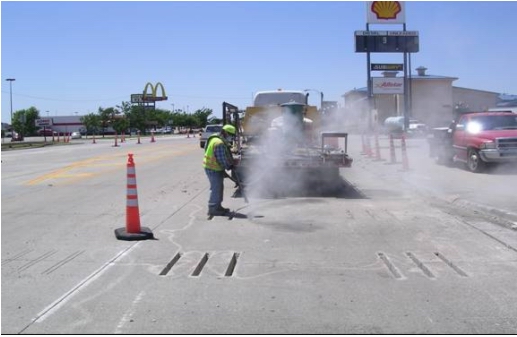
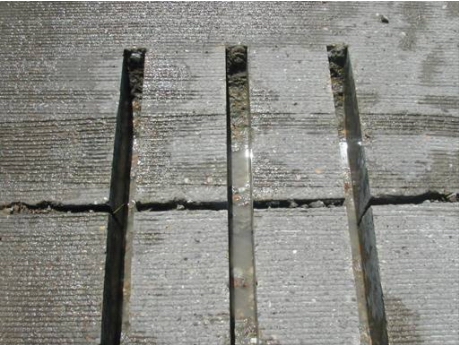
4. Place dowels
Dowels used for DBR are similar to the ones used for new CPCD. Dowels are lubricated with some type of bond breaker. Figure 10-19 shows the dowel bar assembly used for DBR with a joint reformer, endcaps, and chairs. Joint reformer and endcaps allow movement for the slab to expand into without bearing on the patch or bar. Chairs are used to support dowels in the base of the slots and allow backfill material to surround the dowels, and should fit snugly in the slot to keep dowels properly aligned.
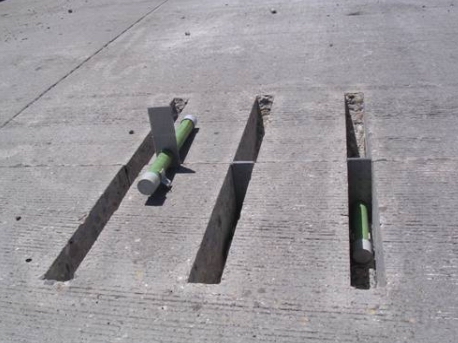
5. Backfill the slots
Once the dowels are placed, backfill materials are applied. Backfill materials should have similar thermal properties to the concrete, provide strong bond to the existing concrete, be fast setting, have little shrinkage, and develop enough strength to allow traffic in a short time. Both high early strength concrete and proprietary mixes have been used successfully. High early strength concrete usually contains type III cement, accelerators, and aluminum power. Accelerators and aluminum powder improve set times and reduce shrinkage. Aggregates in the mix should be small enough to allow the concrete to flow around the bar and consolidate properly.
Consolidation of backfill material is done with a small spud vibrator. Care should be taken not to hit the dowels with the vibrator, since touching dowels with a vibrator will knock it out of alignment.
Once the backfill material is applied, the surface is finished flush with the surrounding surface. Curing compound should be applied as soon as practical. Sawing is done over reformer and the entire project is diamond ground, with re-sealing the joints as a final step. Figure 7 shows the result after DBR, slab jacking, and diamond grinding (DG).

